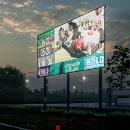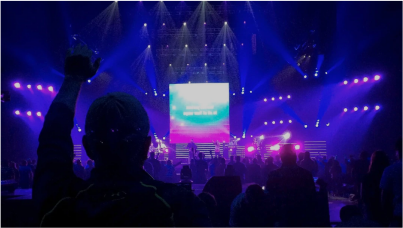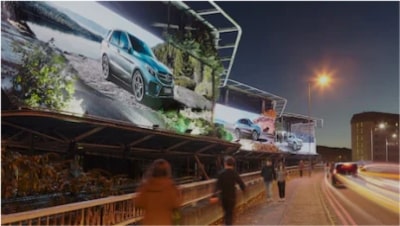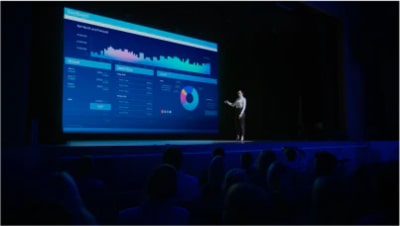LED Video Walls vs Projectors: A Comparative Guide
In recent years, businesses, event organizers, and entertainment venues have increasingly turned to large-format displays to captivate audiences. Two leading options often considered for these applications are LED video walls and projection systems.
Each of these technologies has its own strengths and weaknesses, and choosing the right solution for your needs can significantly impact the success of your project.
In this guide, we'll take an in-depth look at LED video walls and projection systems, explaining how they work, their key differences, and which solution may be the best fit for different use cases.
What Is an LED Video Wall?
An LED video wall is a seamless large-scale display made up of smaller LED panels. Each panel consists of light-emitting diodes (LEDs), which produce their own light to create vibrant images. These panels can be connected in a grid to form a wall of any size or shape, allowing for flexibility in design. LED video walls are commonly used in environments like stadiums, retail stores, control rooms, and outdoor advertising spaces.
How Do LED Video Walls Work?
Each individual pixel in an LED video wall is made up of three LEDs (red, green, and blue). By controlling the intensity of these LEDs, the video wall can produce a wide range of colors, creating a sharp and vivid image. Unlike projectors, which rely on external light sources, LED video walls generate their own light. This means they perform well in a wide range of lighting conditions, both indoors and outdoors.
What Is a Projector?
A projection system consists of a projector that casts an image onto a flat surface, such as a screen or wall. Projection systems are often used in theaters, classrooms, and conference rooms. They have been a popular choice for large-scale displays for many years due to their relatively low cost and versatility.
How Do Projection Systems Work?
Projectors use a light source, typically a bulb or laser, to project an image onto a surface. The quality of the image depends on the projector’s resolution, brightness, and the surface quality. Unlike LED video walls, which are built from individual panels, projection systems require careful calibration to ensure the image is correctly aligned with the screen.
Key Differences Between LED Video Walls and Projectors
Now that we’ve explored the basics of both technologies, let's compare them based on several important factors.
1. Brightness and Image Quality
One of the most critical factors in choosing between an LED video wall and a projection system is brightness. LED video walls offer significantly higher brightness levels compared to projection systems. This is especially important for outdoor applications or well-lit indoor environments, where projections can appear washed out.
LED walls maintain high image quality in any lighting condition, offering rich colors and sharp contrasts. Projectors, on the other hand, may struggle in brightly lit areas and are more dependent on the quality of the projection surface.
2. Resolution
LED video walls typically offer better resolution than projection systems, especially when you consider larger screen sizes. Since LED video walls are modular, you can adjust the pixel pitch (the distance between the centers of two adjacent pixels) to achieve higher resolution depending on viewing distance. Projection systems, however, have a fixed resolution that can deteriorate as the image size increases, making it harder to maintain clarity on larger surfaces.
3. Viewing Angle
LED video walls provide superior viewing angles compared to projection systems. The image on an LED wall remains clear and vibrant from almost any angle, making it ideal for venues with wide seating arrangements or public spaces where people may view the screen from different positions. Projection systems, on the other hand, have a narrower optimal viewing angle. Outside of this angle, the image may appear distorted or dim.
4. Installation and Maintenance
When it comes to installation, LED video walls offer more flexibility. Since they are modular, you can create custom sizes and shapes based on your specific requirements. LED video walls also have longer lifespans and lower maintenance needs. Each LED panel is durable and can be replaced individually if needed.
Projection systems generally require less upfront effort to set up but demand more ongoing maintenance. Bulbs need to be replaced periodically, and the system must be recalibrated to maintain image quality. Additionally, projectors are sensitive to dust, which can affect performance and require regular cleaning.
5. Cost
One of the key advantages of projection systems is their lower upfront cost. For smaller projects or temporary installations, projection systems are often more affordable than the cost of an LED wall. However, it's essential to consider the long-term cost of ownership.
LED video walls, while more expensive initially, tend to offer better value over time due to their lower maintenance costs and longer lifespan. If your project requires a permanent or semi-permanent installation, the durability and energy efficiency of an LED video wall may offset the higher initial investment.
Use Cases: When to Choose an LED Video Wall or a Projector
While both technologies have their merits, each is better suited for certain applications.
LED Video Wall
- Outdoor advertising: LED video walls excel in outdoor environments, offering high brightness levels that ensure visibility even in direct sunlight.
- Churches, concerts and sporting events: For large venues, LED walls provide vibrant visuals that can be seen clearly from long distances and wide angles.
- Control rooms and broadcast studios: When real-time data and high-resolution visuals are critical, LED video walls are an ideal choice due to their image quality and reliability.
Projection System
- Theaters and auditoriums: Projection systems are still an acceptable option for darker environments where ambient light can be controlled.
- Classrooms and conference rooms: For smaller, more intimate spaces, projection systems offer an affordable solution that’s quick to set up.
Which One Should You Choose?
Deciding between an LED video wall and a projection system depends on a variety of factors, including the environment, viewing distance, and budget. If you need a high-quality, long-lasting display that can perform in any lighting condition and offer a broad viewing angle, an LED video wall is likely the better investment. However, if cost is a concern or the installation is temporary, a projection system might be the right choice.
When weighing the pros and cons, consider how each option aligns with your specific goals and constraints. Whether you're hosting an outdoor event, equipping a corporate boardroom, or creating a dynamic digital billboard, the right display can make all the difference in capturing attention and delivering your message effectively.
Final Thoughts: Choosing the Best Display Solution
Both LED video walls and projection systems have their place in today’s display technology market. By carefully considering factors like brightness, image quality, and cost, you can make an informed decision that aligns with your needs. LED video walls offer superior performance in many scenarios, particularly for long-term installations and challenging lighting conditions, but projection systems provide an affordable and flexible option for smaller projects.
Your choice ultimately depends on the specific demands of your project. Understanding the advantages and limitations of each technology will help ensure that you select the display solution that will achieve your objectives, impress your audience, and provide lasting value.










